Dennis Hoyt was invited by His Highness, the Crown Prince of Bahrain and Sheikh Salman (CEO of Bahrain International Circuit) to give a solo exhibition of his work in Bahrain. Drawing in 20,000 people in just three days, it was an overwhelming experience.
How are you Dennis?
I am working feverishly but I'm fine.
Are you working to a deadline?
Well I have a tentative schedule date for an exhibit at the Formula 1 race in Texas in October and I had an exhibit in Bahrain last April and they want me back. So I am doing a multiple show effort here and my agent is now also arranging something else for me concerning my new project.
So are you coming up with something new for the forthcoming exhibitions?
Yes. Everything's going to be brand new. In fact you are one of the first people to actually share that. I'm taking a whole new direction in my art. I'm going away from what most car artists do and away from what car people like to see, which is some sort of a literal representation of an automobile. I'm going to where my heart and my passion is and that's abstract impressionism. I don't know if it will be successful but next year I will certainly get a lot of attention because it's something totally different from what I've ever done before. I've always felt that automotive art should be an interpretation of the automobile and not a literal presentation of it. So that's the direction I'm going in and it's actually where my true heart is.
Okay, but will the topic still be the car?
It will still be the car and I don't want to say almost unrecognizable because you will recognize certain aspects. But I'm more interested in the passion, virility, speed and motion that the automobile conveys and I'm trying to show that in a whole new three dimensional format.
That's going to be very interesting because you already do your work in an abstract way. Have you already started making something?
I finished my first piece in time for the show in Bahrain and it was a tribute to Ayrton Senna. One of the things said about Ayrton was that he was a very colourful individual. So I just tried to play off of that idea and focus on him but you can get an indication that he's in a McLaren. I'm working on a second piece which is even more abstract and consists of about 50 pieces of wood.
How does the process work Dennis?
I've never before sketched anything other than what a client would like to have sketched. But this time I sat down and took a look at several images to get a mental impression of what I want to do. I then just started doing free hand sketching and once I got the sketch comprised of how I felt my impression of the car was at speed, I started carving the pieces. I started with two or three basic pieces and just kept adding onto that and interlocking them. It's a very free form three dimensional piece and it will be about 5.5 feet long (a little over 1.5 m) and it's about 24 inches high. It's wall hanging and I will be focusing on doing some wall hangings, as well as free standing pieces. But they are going to be significantly different from what anyone has ever seen from Dennis Hoyt before.
I really like how you develop and don't stay with just one style. Obviously your current style is popular with the audience but you are taking it to another level because as an artist, you have to.
Yes exactly and I get really bored if I have to do a similar thing. I've taken my previous works as far as I can take them. I now really want to push beyond that and develop new ideas and also the uses of materials. I felt that I was constrained by the format that I had previously established. I agree with you 100%, in my opinion an artist isn't an artist unless he constantly evolves and moves and changes.
Does it also challenge your craftsmanship then? Is your new style more difficult to make?
Yes it is because I am having to look at this now in a whole different context as far as the mechanics go. How to make the pieces fit together and not show any digital means of connectivity. So that the wood, for example on the piece which I am currently working on, is tied together with steel rods here and there but are embedded into the back side of the wood. When you view it, you don't see anything other than wood but structurally there's this steel membrane that's working through the back of it to hold it altogether.
You just mentioned that you start off with sketches. But sketches are too dimensional because they are still on paper. So how does it translate to your 3D sculptures?
Well what I'm doing with this piece now is, I'm only using the sketch as a pattern or layout pattern. As I start carving and shaping the pieces of wood, I think 'well why can't this part rise here' or 'why can't that have an indentation there'. Then I just start letting my mind go and not sticking to any formula as far as how the pieces should fit dimensionally, or how it should connect. So I'm being free with the shapes. Even though it might have the dimensional outline of the 3D sketch, it can end up how I feel on that moment.
Are you working with natural material?
It's all basswood.
Does the wood structure also play a part in what the structure becomes?
Yes it does and there are limitations which I am now trying to overcome. For example, wood has a lineal grain pattern to it and if you cross that grain, it's significantly weaker. I want to keep the wood grain pattern constant, so what I do is I grout a very fine channel in the back of all these pieces and put in steel rods and wires of different dimensions. This maintains the structure and I still have that grain pattern that follows through.
Wow, a lot of skill and technique is needed for that.
Yes that's right and it's trial and error.
I can imagine that sometimes things break and this is why you have come up with the enforcement structure.
Exactly. My ideas allow my mind to be free as to what the shape could be like. Then I figure out a way so that when it's viewed by the customer or the audience, they cannot see how it is done. The pieces overlap and intertwine and I use this because again, I think it depicts motion and speed and virility. It also has a very tactful feel to it and I like the idea of high contrast and the fact that I'm not working on a one or two dimensional surface. I try to make the most of the 3D aspect. It opens up a whole different area in my mind because I'm not confining myself to any given law of how the wood should be put together.
So what is it that you want to express with your art Dennis?
What I want to express is what really gets me excited; how to interpret the idea of speed and motion in 3D. How many ways can you express the virility, the passion, the movement and motion and all of the things that go into making an automobile go very fast. I want tension within the piece, I want grace within the piece and yet I want this underlying feel of 'my God it's coming apart' or 'my God it's going 150 miles per hour'. This is what I'm trying to do now with the shapes and also with the colours. My current piece is going to different from before because then I used one or two primary colours in my work. Now it's going to be multi facetted because of multi colours. I want to have different values and different levels of colour values within two or three pieces of wood. So you get again another dimension from the 3D effect.
My new piece will be unveiled in April in Bahrain. There are no limits to where I see my new direction going. I can visualize pieces that are 30 meters long and 15 meters high. You can't do that by doing a literal version of something. I want to take it beyond that. I want to explode the whole idea of what automotive art can be. The thing is, I don't want to call it automotive art. I just want to call it art.
I think by hanging the name automotive art on it, you put it in the niche market and limit its' appeal. Plus the mainstream art world will shut the door as soon as you say the word automotive art. This has been my experience now for twenty years. The art market has changed in the last four or five years in that a lot of the people who were buying automotive related art are no longer doing that. The younger generation aren't so interested in automobiles and therefore, there's less interest in automotive art. You find a lot of automotive artists standing on the side lines wondering what to do next. So I've gone my own way. I don't know if I will be successful but I just need to do it. I can't continue to do the things I've done in the past.
The French impression artists followed their heart and went against the mainstream and look how that turned out. So I think you are right to follow your heart Dennis.
I hope so and I'm not going back to what I did before. Whether it will be commercially successful, I don't know. I just have a gut feeling that it will be because it opens up a whole new market. On my current new piece, I've got three small more pieces to detail and then I will bleach all of the wood and start the colouring process of dying the wood. Then I'll put a sealer on it and after that, do an assembly.
And you are bringing it to the automotive exhibition?
Yes. Bahrain invited me last year and want me back. Bahrain is the first international country who has asked me to do a solo exhibit. I told them that because they were the first, I would introduce new pieces next year. They talked about me coming back in January to do a lecture to students and then to come back in April to show the exhibit during the F1 race.
You are the only one doing this. Do you feel inspired by other artists?
Some of my favourite past artists are Pollack, Alberto Giacometti. There have been some artists from the past who I really admire and there are some new artists who sometimes produce something which I think is really good. But most of my inspiration comes from watching the cars at speed and seeing the blurred motion of colours and that's what I try to capture. What the motion looks like two hundredths of a second after it's gone by. This is how my mind is constantly working.
So how do you capture those moments?
I just see them in my minds' eye and I try to replicate them. That's what I am doing with my new work as well.
Do you go to a lot of races as a spectator?
Not really. I don't go to that many because I am mainly in my studio working. I would like to attend as many F1 races as I could, and I would love to be at Le Mans one day but so far, I've not had the time to do that. The Bahrain F1 was fantastic and the people were wonderful. I enjoyed myself immensely. They treated me like royalty. I received 20,000 people in three days. It was absolutely unbelievable the amount of people who came through the exhibit area. So I was just overwhelmed by it all.
That was your solo exhibition?
Yes it was by invitation of the Bahrain International Circuit and by the Crown Prince of Bahrain. I had an audience with His Highness, the Crown Prince of Bahrain and Sheikh Salman (CEO of Bahrain International Circuit) and a couple of others and of course Mr. Ecclestone. It was an overwhelming experience for me but I got the taste of it and I love it. So I want to go back.
I can imagine and that it will help you go forward with your ideas of larger dimensional sculptures.
Exactly and that's what my wish is; for people to start realizing that there is a large area where we can really be creative with materials and do something that the world has never seen before. I've done a lot of research on the internet and I'm not doing what other people are doing. I don't want to be like everybody else or do what everybody else is doing. As soon as I see something that is kind of like what I visualize, I think nope I'm not going there and I change it.
Is your style being copied?
Oh yes. I'm seeing more and more people doing the style that I've been doing for ten or fifteen years. So now it's time for me to move on and leave them to do what I was doing fifteen years ago.
It's pretty unique because you are combining wood techniques with painting as well. How did that develop? Did you have an education for that?
Well I actually got pretty bored with all the art schools and dropped out of almost all of them. To me, what they were trying to teach was all rudimentary. I understood all that and wanted to move on. I had the idea that I wanted to learn something different and they weren't teaching that. I was very impatient from an early age and then when I started doing my carving and sculpting of cars, I started looking at ways to change the appearance and then thought of colour. I did a lot of research on different types of colouring processes. I finally settled on dyes which allow the wood grain to show through and I can get all these marvellous wonderful colours. I found that I could mix them with a lower grade of alcohol and it would give me the colours I wanted. I tried Ukrainian egg dyes, food dyes, everything I could get my hands on. I couldn't ask anyone because no-one had done that before. So it was trial and error and I was actually buying dyes from ink manufacturers because you couldn't get them any place else. Now 15 to 20 years later, there are a lot of people making dyes.
The challenge for many artists is that once they have a steady income, it limits them to take risks.
Exactly. When my new work comes out next year, you will see that it's different from what anyone else is doing.
Keep posted on CarArtSpot to see Dennis Hoyt's new projects. Coming soon!
To see more work from Dennis Hoyt, please visit his website.

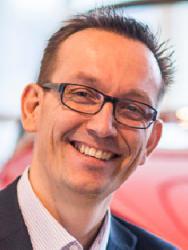
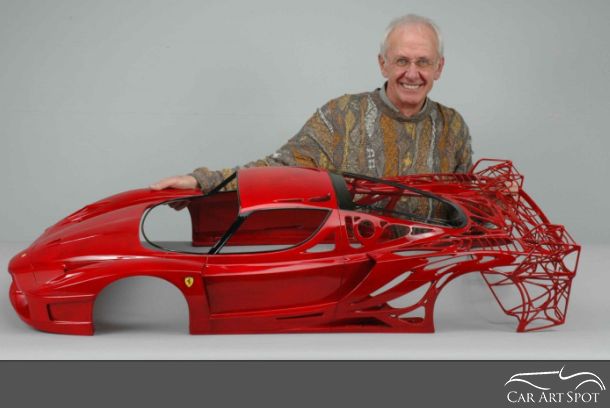
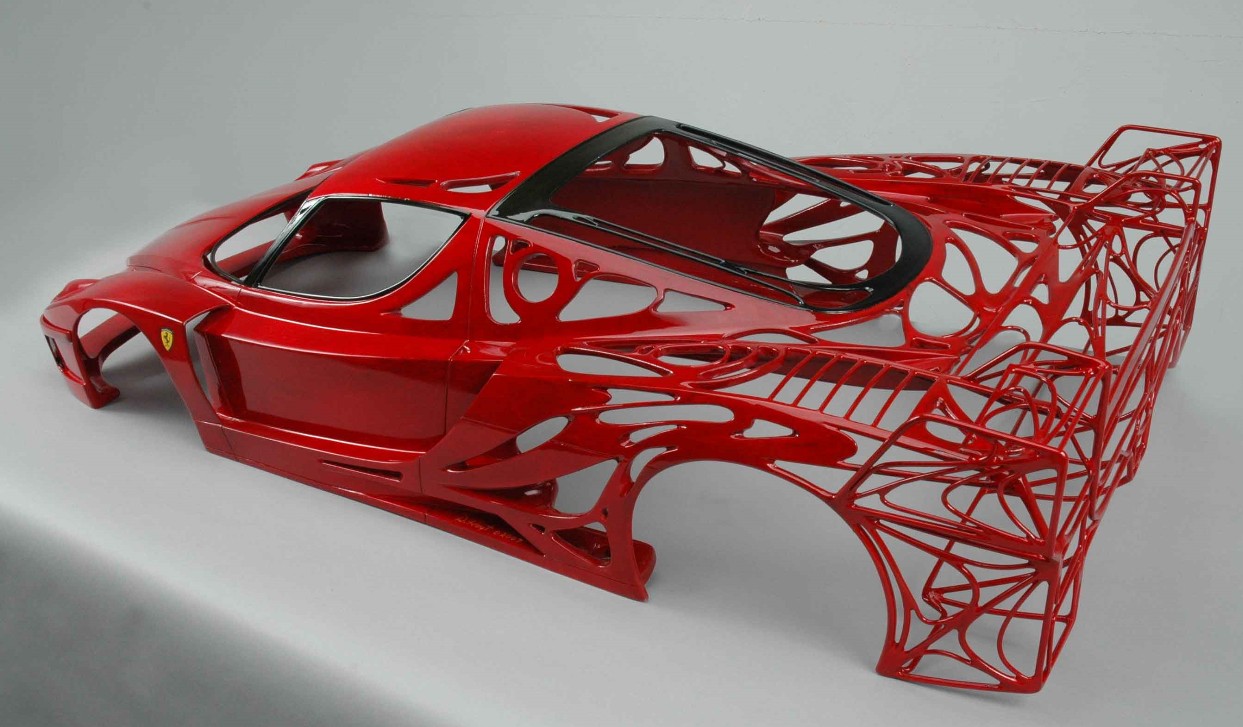
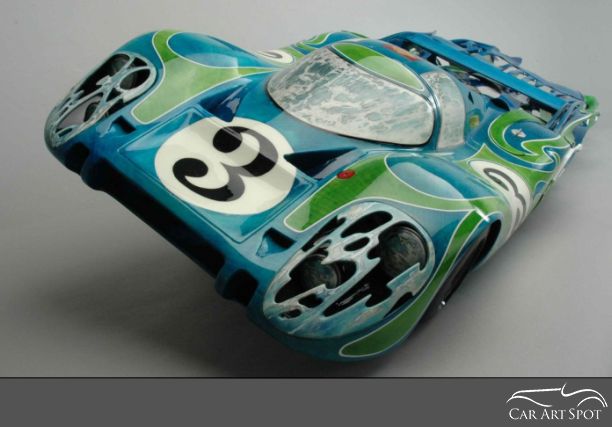
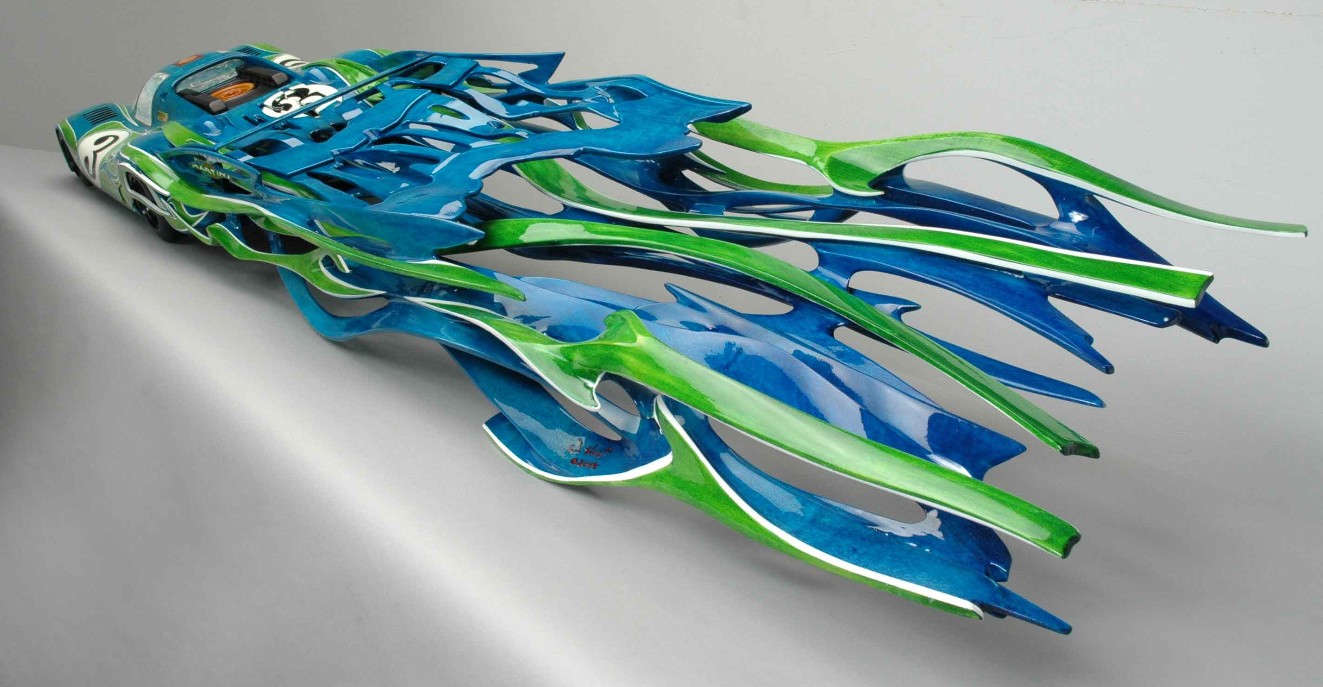
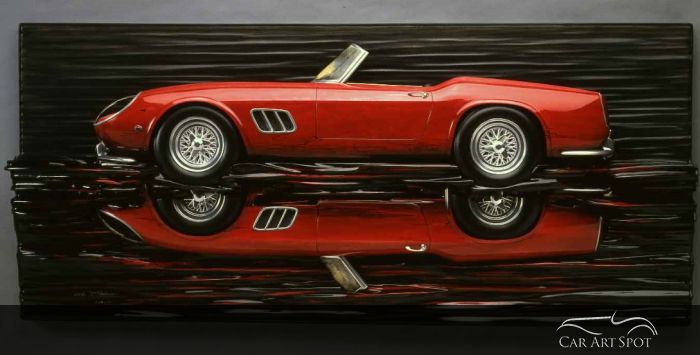
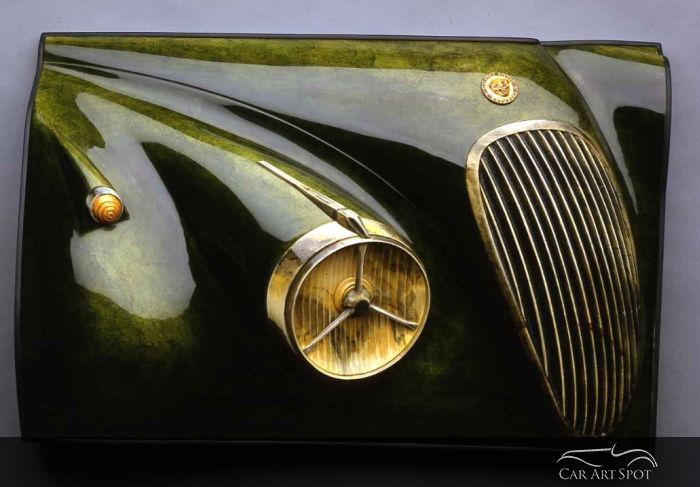
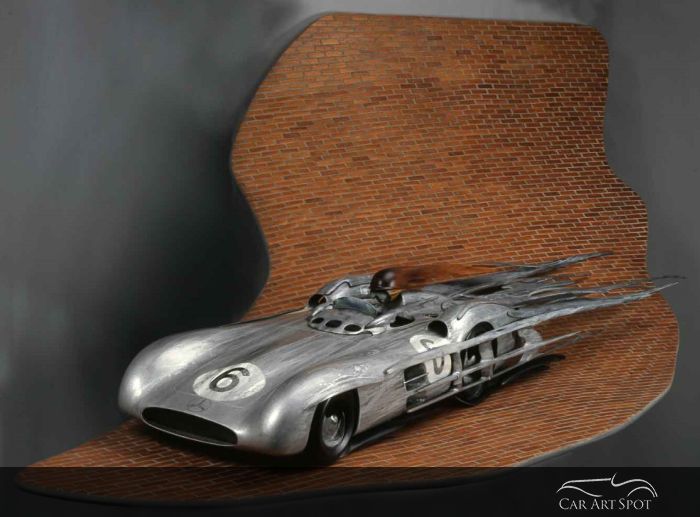
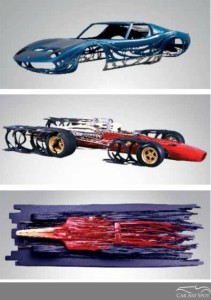
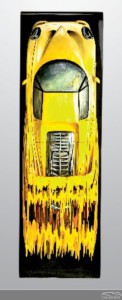
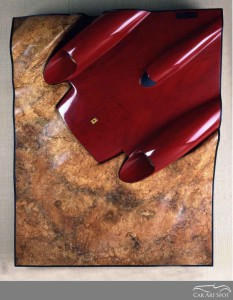
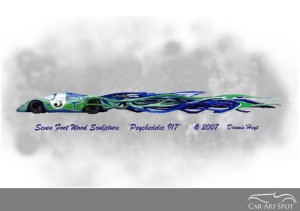
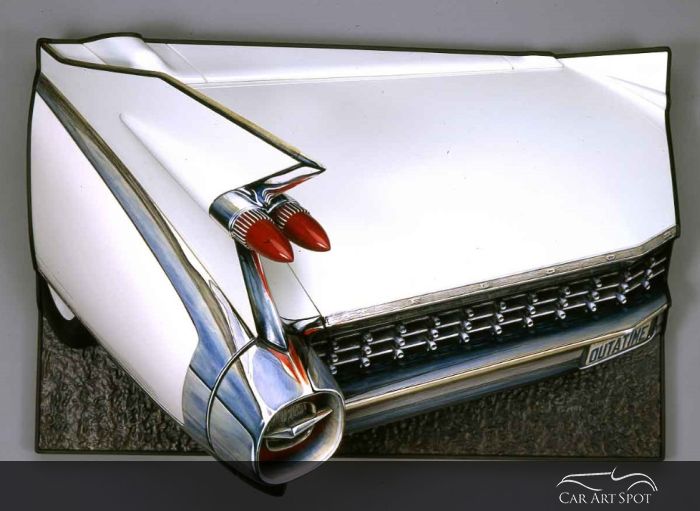
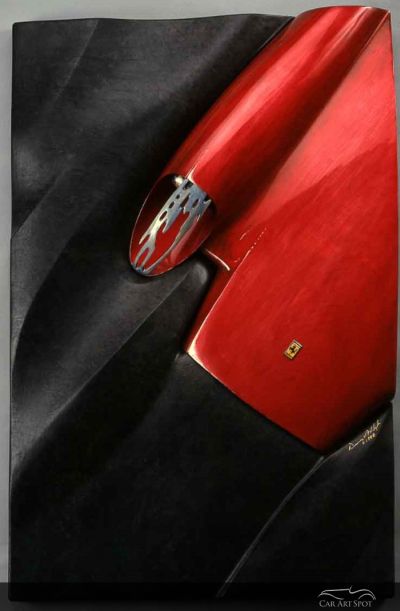
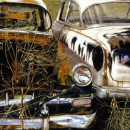
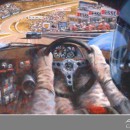
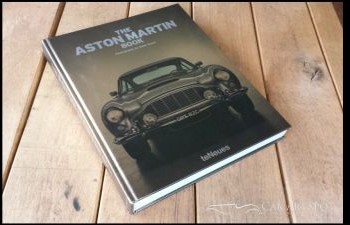
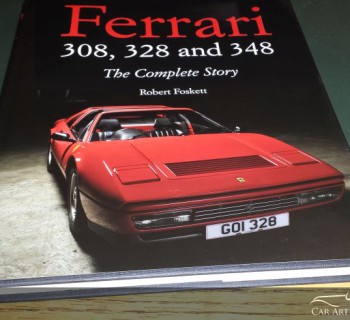
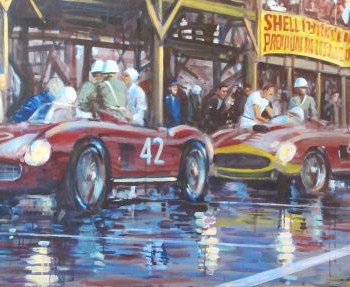
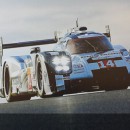
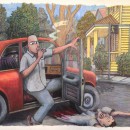


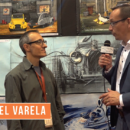
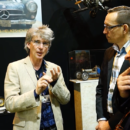
[…] virgolettati di Hayt sono ripresi dall’articolo Dennis Hoyt’s Solo Exhibition di Marcel Haan di Car art […]
[…] http://www.carartspot.com/car-art/artists/car-art-blog/dennis-hoyts-solo-exhibition.html […]
[…] Read our other interview with Dennis Hoyt. […]